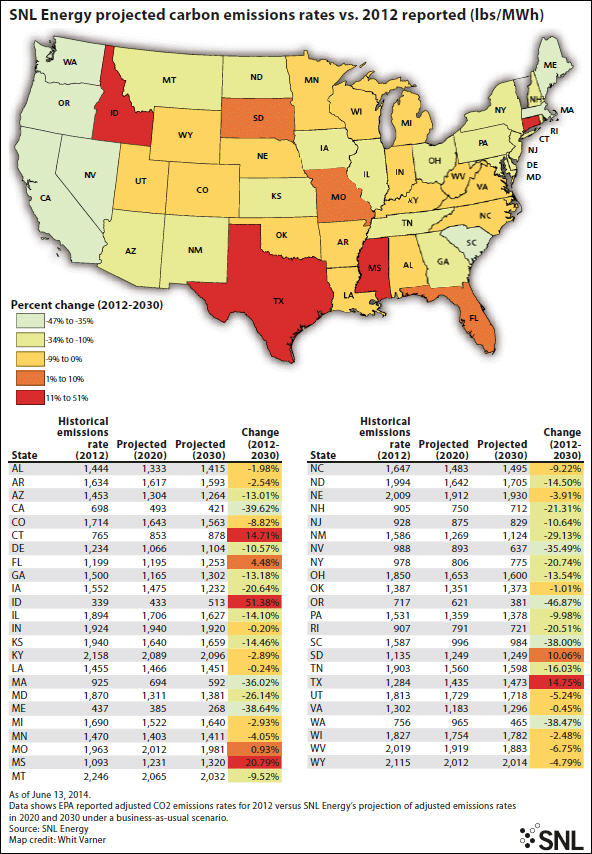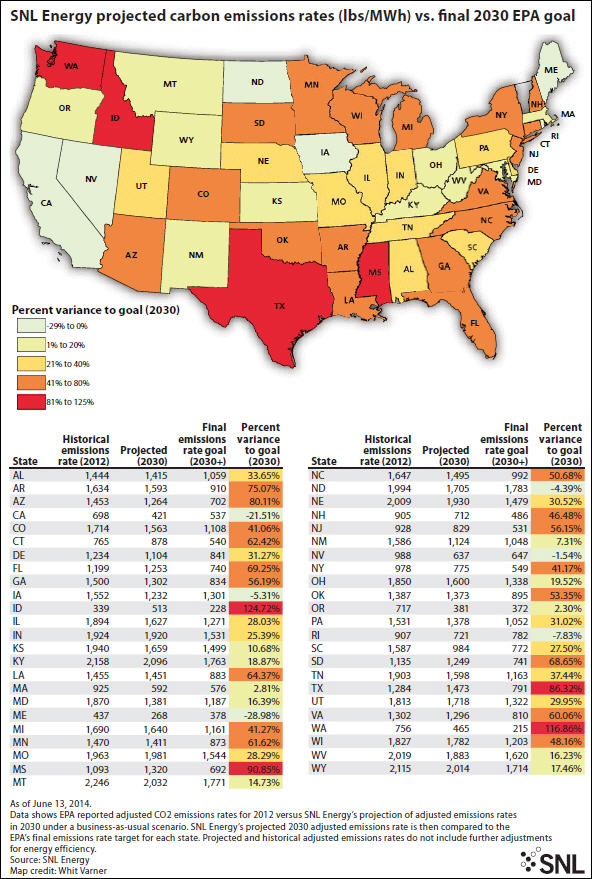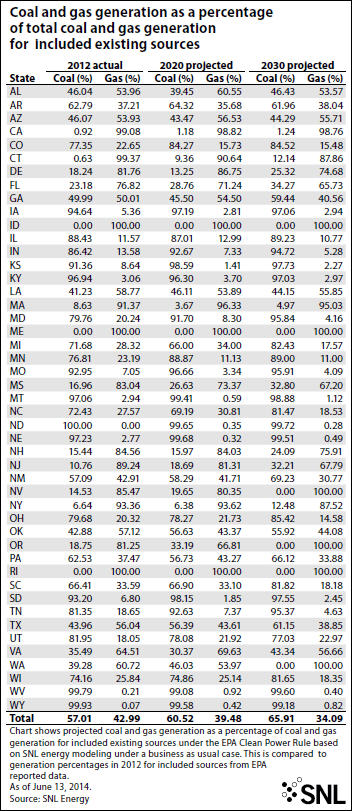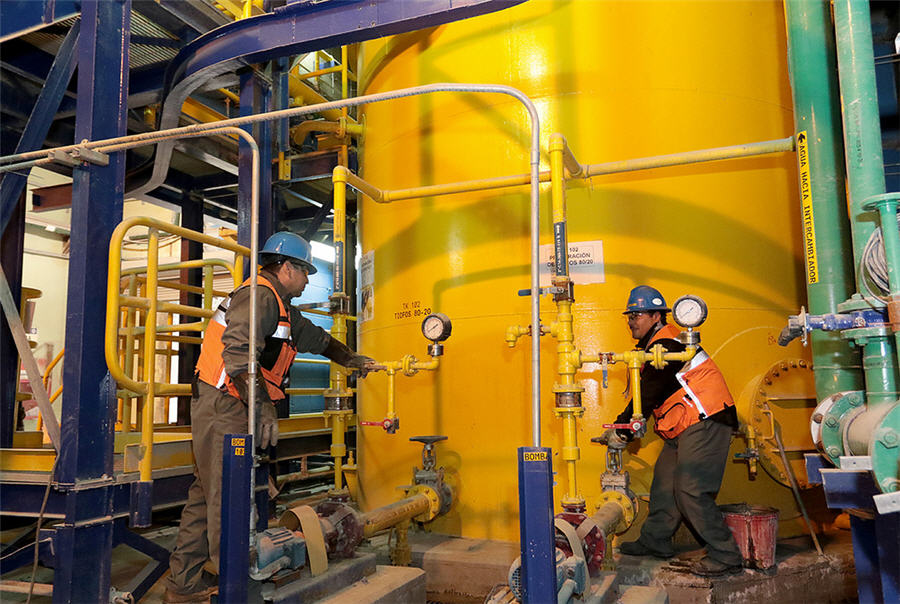Most states need more cuts to meet proposed CO2 rule: SNL Energy
As the nation continues to digest the U.S. EPA’s proposed CO2 emissions limits for covered existing power plants, industry experts have highlighted competing factors influencing the ability of states to reduce CO2 emissions in the face of the proposed regulation.
While considerable uncertainty remains about the nature of the proposed rule and how states would implement it, SNL Energy Research and Advisory Services projections of a business-as-usual case without the rule show that most states would see their CO2 emissions decline but they would need to take additional steps to comply with the rule.
In conducting the analysis, SNL Energy projected CO2 emissions for units covered by the EPA’s Clean Power Rule in 47 of the 49 covered states, taking the impacts on future unit dispatch from upcoming coal retirements spurred by the EPA’s Mercury and Air Toxics Standards as well as expected renewable generation growth. State-level emissions rates for covered units were then adjusted for the addition of new and existing renewable generation, the avoided retirement of at-risk nuclear units and new nuclear units under construction. (To see more details on SNL Energy’s methodology, please see the “About the data” section below.)
Those projections show that 40 of the states analyzed by SNL and covered by the EPA’s proposed CO2 emissions rule are on track to post a decline in adjusted CO2 emissions rates compared to 2012, but only six states would see their CO2 emissions rates fall below the EPA’s proposed requirements without taking specific steps to comply with the rule.
Meanwhile, the projections show seven states increasing their average emissions rates from existing sources compared to 2012, while 41 states would have higher CO2 emissions rates in 2030 than the final emissions rate goal set by EPA.
2012 emissions rates could prove a tough year to beat
While EPA’s announcement mentioned a goal of a 30% decrease in CO2 emissions by 2030 from 2005 levels, 2012 average emissions rates for coal and gas-fired generation facilities were used in setting the 2030 target rates. Utilizing 2012 emissions rate data as a base year could prove to be a tough year to beat as states try to hit 2030 emission rate targets set by the EPA. A variety of factors collided to create a perfect storm of rock bottom average emissions rates in 2012, with some of those factors already subsiding, resulting in increased emissions in 2013.
Natural gas prices, which plunged to better-than-10-year lows in 2012, were a major catalyst for CO2 emissions from power generation hitting the lowest levels seen over the past decade. With the explosion of supply from shale gas and mild weather, 2012 Henry Hub yearly average spot natural gas prices were $2.76/MMBtu, down 31% compared to the 2011 annual average. Sustained low prices throughout the year made gas-fired generators extremely economical to run and caused an unprecedented amount of coal to gas switching. Coal plants — the highest-emitting source of CO2 among generators — found themselves increasingly out of the money, while more efficient, lower CO2-emitting gas units accounted for almost 30% of net generation in 2012. Coal, which accounted for about 51% of net generation in 2002, had fallen to 38% of net generation among all fuel sources in 2012.
As coal-fired generators occupied a seat further down the dispatch curve in 2012, low energy demand in the United States further decreased the amount of CO2 emissions in 2012. Total retail electric sales declined about 1% in 2012 to 3,702,641 GWh from 3,755,779 GWh in 2011. Mild winter weather helped keep retail electric demand low in 2012. Nationally, heating degree days were 21% below the norm for the first quarter. While all three months in the quarter experienced lower-than-average HDDs, March proved to be exceptionally mild: HDDs were trailing 36% compared to the historical average and the previous year.
Additionally, net generation from renewables is a carbon-free source that provides substantial bottom line impact to a state’s average CO2 emissions rate. 2012 proved to be a banner year for electricity creation from renewable sources as projects partially spurred by government incentives became operational. Wind saw an impressive increase of about 17% on 139,727 GWh of net generation in 2012, up from 119,892 GWh in 2011. Meanwhile, net generation from utility-scale solar facilities more than doubled, recording 4,408 GWh in 2012 compared to 2,019 GWh in 2011.
While more capacity is expected from renewables in the immediate years ahead — the wind sector is working through a pipeline of safe-harbored wind projects that are still eligible for the production tax credit, and the solar industry has the 30% investment tax credit through 2016 — future renewables growth could suffer if those programs are not renewed.
SNL Energy projections show emissions rates falling for most states
Under SNL Energy’s business-as-usual scenario, the largest CO2 adjusted emissions rate decreases would occur mostly in the Pacific West and Northeast. Many of these states utilize renewable generation and have an RPS program in place to incentivize future build.
Oregon posts the largest decrease in CO2 emissions rates by 2030 with an almost 47% drop to 381 lbs/MWh, from a rate of 717 lbs/MWh in 2012. Although the state is anticipated to have 14,770 GWh from renewable generation by 2030, emissions from fossil-fueled generation from existing sources take a sharp downward turn as the state’s only coal unit is forecast to cease operation toward the end of the decade.

California posted the second-largest decrease in 2030 forecast adjusted CO2 emissions rates. The state is expected to emit 421 lbs/MWh in 2030, an almost a 40% drop from the 2012 rate of 698 lbs/MWh. California’s place as a leader in CO2 emissions reductions comes as little surprise. In 2013, the state implemented a cap-and-trade program for greenhouse gas emissions. Currently, only phase one of the program is in effect, which includes all major industrial sources and electric utilities. Phase two will start in 2015, and will encompass distributors of transportation fuels, natural gas and other fuels.
According to SNL Energy’s forecast, average unadjusted CO2 emissions rates from plants fired by fossil fuels within California would actually increase slightly, rising about 1% in 2030 to 931 lbs/MWh from the 2020 level of 919 lbs/MWh. The main driver in decreasing the adjusted CO2 emissions rate is the state’s planned addition of renewables. According to SNL Energy estimates, renewable generation within California will account for almost 72,244 GWh in 2030 — making it far and away the largest producer of renewable energy in the U.S.
Although the bulk of states are forecast to reduce their adjusted CO2 emissions rates compared to the EPA’s 2012 base year, a handful do experience higher future emissions rates. Idaho posts the largest increase, up about 51% to about 513 lbs/MWh, compared to 2012 CO2 emissions rates of 339 lbs/MWh. Idaho currently has neither a renewable portfolio standard nor goal in place.
Mississippi — another state lacking an RPS — is expected to have the second-largest increase in CO2 emissions rates from existing sources. Adjusted carbon emissions rates would rise to 1,320 lbs/MWh in 2030, an increase of almost 21% from 2012 levels of 1,093 lbs/MWh, as coal generation gains in market share of total covered-source generation. Mississippi would have almost no CO2 emissions offset from renewable generation. The state is expected to have the lowest contribution of net generation from renewables in the nation, at about 19 GWh in 2030.
Texas, another notable state that could see an increase in adjusted CO2 emissions rates absent further action, is projected to see the adjusted CO2 emissions rate rise nearly 15% from 1,284 lbs/MWh in 2012 to 1,473 lbs/MWh by 2030. While Texas does have an RPS program, requirements under that program have already been satisfied, so any new renewables would have to be driven by the market. Texas also saw coal-to-gas switching in 2012, which effectively pushed down CO2 rates for existing sources. Relative to the 2012 base year, coal gains market share among existing sources in Texas as coal-versus-gas economics improve. Significant load growth — some of the strongest in the nation — also drives further usage of the coal fleet going forward.
SNL Energy projections show most states above EPA goals
According to SNL Energy projections, 41 states would have higher CO2 emissions rates in 2030 than the final emissions rate goal set by EPA — not including future gains from existing energy efficiency, which could bring adjusted emissions rates closer to in line with EPA targets, but were not included in the analysis. The Southeast and Gulf states, many of which do not incentivize renewable generation through RPS, saw some of the largest variances between 2030 projections and EPA final emissions rate goals.

Among states on track to meet the 2030 final emissions rate goal, Maine exceeded the target by the most. The state is expected to have an adjusted CO2 emissions rate of 268 lbs/MWh, almost 30% lower than the 2030 final emissions rate goal of 378 lbs/MWh, and although the state would exceed the target, Maine would barely decrease its unadjusted CO2 emissions rate in 2030 — 872 lbs/MWh compared to 873 lbs/MWh in 2012. Instead, an increase in renewable generation drives much of the emissions reductions for the state; by 2030, almost 7,269 GWh is expected to be from renewable sources. Maine could very well cut emissions further under the target as the state has energy efficiency rebates and loan programs.
Behind Maine was another renewable-heavy state, California, which is projected to exceed its goal by almost 22%.
Idaho would fall short of the final emissions rate goal by the largest variance with a projected rate of 513 lbs/MWh, almost 125% above the target of 228 lbs/MWh. While Idaho does not have an RPS in place, it has a number of ongoing energy efficiency efforts, which could help to lower its adjusted CO2 emissions rates once factored in. Idaho is one of only nine states that offer an income tax deduction for energy efficiency. Idaho also offers utility-level rebates and state- and utility-level loans to incentivize energy efficiency.
Although Washington is expected to cut 2012 CO2 emissions rates by about 38%, the state would still miss its 2030 final emissions rate goal by the second-largest variance of almost 117%. The state is projected to have an adjusted CO2 emissions rate of 465 lbs/MWh, compared to the EPA goal of 215 lbs/MWh. Achieving the additional required reductions under the final emissions goal could require changes, as there are currently no statewide tax incentives, rebates, grants or loans for energy efficiency. The only state-level energy efficiency program is a green building incentive that applies to low-income residential property. However, the state does have various utility-level rebates, grants and loans for energy efficiency.
 Coal generation expected to increase versus gas without CO2 rule
Coal generation expected to increase versus gas without CO2 rule
Among existing sources, output from coal and gas units comprises the vast majority of covered generation. With a large disparity between the CO2 emissions rates of gas and coal plants, changes to the relative share of generation coming from coal and gas can have a big impact on realized CO2 emissions rates.
Although 40 states covered under SNL Energy’s carbon emission forecast would post a decline in adjusted CO2 emissions rates from existing sources in 2030 compared to 2012, 34 states would increase their percentage of total coal and gas generation coming from coal in 2030, relative to the 2012 base year.
In 2012, coal generation accounted for about 57% of total coal and gas generation for included existing sources among the contiguous U.S. covered under the rule. SNL Energy projects the proportion of coal to gas generation to rise in 2030, with coal increasing its share of net generation about 9 percentage points to almost 66%.
Natural gas prices rising from the rock bottom experienced in 2012 is one of the major drivers for coal generation regaining some of its market share from gas. Low prices from shale gas fracking drove all but the most efficient coal units to the margin in 2012. In 2014 prices at the Henry Hub have generally remained above $4/MMBtu, allowing more coal units to be cost competitive. After falling from early 2014 price spikes on cold winter weather, natural gas prices have begun to creep toward $5/MMBtu at the Henry Hub as ongoing natural gas storage deficits continue to pressure markets.
Upward pressure on gas prices is expected to continue as the nation builds almost 41 Bcf/d of export capacity. Although the first facility — trains 1 and 2 of the Cheniere Energy Inc.-owned Sabine Pass Liquefaction Project — is not expected to be complete until 2016, the significant outflow of gas to foreign countries may have an impact on domestic gas prices.
According to the 2014 “Annual Energy Outlook” from the U.S. Energy Information Administration that compared prices and changes in real 2012 dollars, natural gas prices are expected to rise almost 89% from 2012 values to $6.49/MMBtu in 2030. Coal, on the other hand, is anticipated to be $2.93/MMBtu, an increase of about 22% compared to the 2012 price of $2.39/MMBtu.
New Jersey would see the largest percentage point shift in coal generation compared to total coal and gas generation within the state. Coal-fired generation would increase to 32% of the generation between the two sources, an increase of about 21 percentage points from about 11% in 2012.
Texas would see the second-largest shift from gas to coal by 2030, up more than 17 percentage points to about 61% compared to 44% in 2012.
Introduction of carbon taxes
One of the key mechanisms for reduction of average CO2 emissions rates under the EPA’s proposed rules is redispatch of coal generation toward natural gas. In order to assess how carbon prices might influence the dispatch of coal versus gas and thus resulting CO2 emissions rates, SNL Energy ran dispatch simulations with carbon taxes introduced for generators not participating in existing state-level or regional CO2 cap-and-trade programs.
Among states without an existing CO2 cap-and-trade program, Virginia would see the largest decline in its carbon emissions rate with the introduction of a $10/ton carbon tax. The unadjusted CO2 emissions rate from existing sources for the state in 2030 are expected to be 1,432 lbs/MWh, but a $10/ton carbon tax would cause an almost 13% drop in emissions rate, to 1,251 lbs/MWh.
The second-highest impacted state due to the introduction of a carbon tax would be Mississippi. Highly reliant on fossil fuels, the state would experience a decline in unadjusted emissions rate of almost 12%, from 1,344 lbs/MWh under the business-as-usual case to 1,186 lbs/MWh with a $10/ton tax. Other Southeastern states would also likely see sizable reductions in CO2 emissions rates from the introduction of a modest carbon tax as these states were some of the first to see price-based coal-to-gas switching after 2010 and generally have the least disparity between coal and gas economics.
 In states with efficient units burning low-cost Powder River Basin coal, a $10/ton carbon tax would likely have little impact. If Oklahoma instated such a tax, unadjusted emissions rates would decrease to 1,593 lbs/MWh from 1,651 lbs/MWh under the business-as-usual case. However, if a $20/ton tax were introduced, the CO2 emissions rate would drop almost 17% to 1,372 lbs/MWh.
In states with efficient units burning low-cost Powder River Basin coal, a $10/ton carbon tax would likely have little impact. If Oklahoma instated such a tax, unadjusted emissions rates would decrease to 1,593 lbs/MWh from 1,651 lbs/MWh under the business-as-usual case. However, if a $20/ton tax were introduced, the CO2 emissions rate would drop almost 17% to 1,372 lbs/MWh.
Louisiana would experience a similar outcome, achieving an almost 3% reduction in CO2 emissions from a $10/ton carbon tax. A $20/ton tax would bring the business-as-usual 1,502 lbs/MWh CO2 rate down about 13% to 1,300 lbs/MWh.
About the data
SNL Energy examined projected CO2 emissions for existing units included in the EPA’s Clean Power Rule for existing sources. The list of included generating units from the EPA was used to establish resource participation and includes generators added since 2012 as well as units under construction as of January 2014. Sources of CO2 emissions located on Native American lands are excluded from state-level aggregations: South Point Energy Center, within Arizona; Navajo Generating Station, within Arizona; Four Corners Power Plant, within New Mexico; and Bonanza Power Plant, within Utah. Emissions for included units were aggregated by state for each forward year from 2020 to 2030 under a business-as-usual, or BAU, case, as well as two additional cases that examine the impact of carbon taxes on generator dispatch and resulting emissions. Emissions were assessed from forward dispatch simulations using the Auroraxmp tool. Auroraxmp is a power market simulation tool based on an hourly dispatch engine that simulates the dispatch of power plants in a chronological, multizone, transmission-constrained system and is widely used for electric-market price forecasting, resource valuation and market risk analysis.
SNL Energy’s BAU case considers the impacts on future unit dispatch from upcoming coal retirements spurred by MATS as well as other programs expected to be in place such as state RPS requirements, but does not consider the impacts of the new EPA carbon rules. Unit dispatch also was examined under the BAU case with the addition of carbon taxes including a carbon tax of $10/ton (in 2010 dollars) placed on participating units which do not have a current CO2 market structure in place (non-RGGI and California) as well as a $20/ton (in 2010 dollars) tax.
For each state, an output weighted average CO2 emissions rate was calculated for each forward year studied that represents an aggregate unadjusted emissions rate for participating fossil units. In addition to published historical unadjusted emissions rates, the EPA also published an adjusted 2012 CO2 emissions rate for each state. The adjusted emissions rate is calculated by taking an output weighted CO2 emissions rate for covered sources and altering it by adding to the denominator generation from non-hydro renewables as well as the assumed generation from new nuclear capacity under construction and a state-level estimate of generation from avoided at-risk nuclear retirements. This effectively reduces weighted average emissions rates by including in the weighted average these carbon-free resources.
For comparison purposes, SNL Energy calculated a similar forward looking adjusted CO2 emissions rate using the EPA’s own assumptions for under construction and at-risk nuclear capacity as well as projected renewable capacity based on existing and planned renewables as well as renewables likely to be built under existing state RPS requirements. This adjusted emissions rate is calculated for illustrative purposes and is not intended to be indicative of state compliance with the new carbon rules. This adjusted rate also does not include the impacts of efforts already underway in states to promote energy efficiency, which also would tend to lower the adjusted CO2 emissions rate for a state.
{{ commodity.name }}
{{ post.title }}
{{ post.date }}

Comments
klgmac
And the dismanteling of the US economy over a phony crisis continues apace.